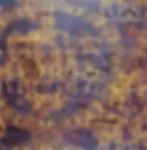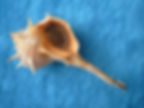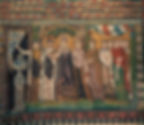Tyrian Purple: A Color of Royalty
- Alessandra Cipolloni
- Dec 4, 2023
- 9 min read
Updated: Dec 4, 2023
Tyrian Purple, otherwise known as a different shade of Purple in the English language, stands as a chromatic embodiment of the historical richness and cultural significance of colors. This article navigates through meanings and centuries, tracing the origins and multifaceted evolution of Tyrian Purple, revealing its strong impact on diverse societies (Falcinelli, 2017).
Purple’s footprint extends across many periods, leaving indelible marks on the “regalia” of ancient monarchs, the symbols and emblems of royalty, the sacred spaces of religious practices, and the tapestry of cultural symbolism. This article aims to uncover the threads that weave Purple into the very fabric of human history, exploring its role as both a pigment and a potent cultural symbol.
From the majestic robes of emperors to the liturgical vestments of religious leaders, Purple has adorned those in positions of power and reverence. The color's journey transcends mere aesthetics, becoming a visual narrative of authority, spirituality, and societal structures. By examining its historical applications, the unraveling of stories embedded within the folds of Purple echoes through the corridors of time.

Culturally, Purple has held diverse meanings and associations. Its presence in rituals, ceremonies, and artistic expressions speaks to its role as a symbol deeply ingrained in the collective consciousness of civilizations. This exploration seeks to illuminate the cultural contexts that have bestowed Purple with layers of significance, shedding light on the nuanced ways it has been employed and interpreted.
In dissecting the historical and cultural importance of Purple, one not only uncovers the chromatic palette of the past but also gains insights into the societal values, power dynamics, and spiritual underpinnings that have colored human existence. As individuals immerse themselves in the hues of Purple, there is an opportunity to navigate the historical labyrinth where this color transcends pigment, becoming a vector for understanding the complex interplay between societies and the colors that adorn their narratives.
History of Tyrian Purple
The historical narrative of the color Tyrian Purple, rooted in the ancient world, unravels a saga of both biological intricacy and socio-cultural significance. Biological pigments, a closely guarded secret among manufacturers due to their arduous acquisition, bestowed upon the ancient world the elusive Tyrian Purple , extracted from the mucus of various Murex snail species. Originating as early as 1570 BC with the Phoenicians, its production continued through the epochs, passing the baton to the Greeks and Romans until the fall of Constantinople in 1453 AD. This precious pigment, an embodiment of power and opulence, became a hallmark of elite status, contributing to the enduring perception of Purple as a "royal color” (Rinaldi, 2011).
Tyrian Purple, so named for its association with the Phoenician trading empire, was not merely a pigment but a manifestation of societal structures. The expense and labor-intensive nature of its production rendered it a commodity of great value, with historical records indicating its weight in silver as a benchmark for its cost. The textile industry of the time, colored with Tyrian Purple, thus became a canvas reflecting not only the technological achievements of the era but also the intricate tapestry of socio-cultural relationships, fashion trends, and trade connections.
The hue itself, prized for its resistance to fading and the intriguing transformation of becoming brighter with exposure to weathering and sunlight, manifested in various shades. The most coveted variant was that resembling black-tinted clotted blood, an evocative descriptor that adds layers to the mystique surrounding this ancient pigment. The allure of Tyrian Purple was so profound that its use extended beyond aesthetics; it became a symbol of status, subject to strict sumptuary laws that regulated its usage.

In the Roman context, the toga praetexta, adorned by the most senior magistrates, bore the distinguished white hue edged in Tyrian Purple. Generals celebrating triumphs elevated the spectacle with the toga picta, a solid Tyrian Purple garment embellished with gold thread. Such sumptuous displays of the color were restricted by law, emphasizing the exclusivity and prestige associated with Tyrian Purple. By the fourth century AD, only the Roman emperor was granted the privilege of donning Tyrian Purple, cementing its role as a symbol of imperial authority (Stieglitz, 1998).
The Byzantine Empire continued this legacy, tightly controlling the production of Tyrian Purple and subsidizing its use exclusively for the coloring of imperial silks. The dye extracted from the Bolinus brandaris, speculated to be the argaman in Biblical Hebrew, adds an intriguing layer of connection between the ancient pigment and historical references. Moreover, the symbolic term "porphyrogenitos," meaning "born in the purple," emerged in the 9th century to designate a child born to a reigning emperor, further intertwining the color with imperial lineage.
This rich historical tapestry, woven with threads of commerce, legislation, and cultural symbolism, positions Tyrian Purple at the nexus of ancient civilizations. Its journey from the sea snail to the imperial courts reflects not only a chromatic evolution but a narrative of power, prestige, and the enduring legacy of a color that transcends the boundaries of time.
Rarity of Tyrian Purple
The distinction between Purple and violet lies in the nuanced interplay of color perception. Purple, positioned on the color wheel between red and blue, is a composite hue resulting from the blending of these two primary colors. It tends to be warmer, with a reddish undertone. On the other hand, violet is a spectral color with its place in the visible light spectrum, residing between blue and ultraviolet. Unlike Purple, which is a combination of colors, violet is a single wavelength of light and is often associated with a cooler, bluer tone. In essence, while Purple is a secondary color created by human perception through the amalgamation of red and blue, violet is a distinct color on the spectrum, reflecting a singular wavelength of light and embodying a cooler and more blue-centric hue (Schneider, 1978).
The intricate history of Tyrian Purple, the royal dye of antiquity, unfolds as a tale of nature's alchemy and human ingenuity. Sourced from the mucous secretion of predatory sea snails, the likes of Bolinus brandaris (the spiny dye-murex), Hexaplex trunculus (the banded dye-murex), and Stramonita haemastoma, this coveted substance is an organic compound of bromine, an uncommon find in land animals but prevalent in marine life. Set against the backdrop of the eastern Mediterranean Sea and the Atlantic coast of Morocco, these medium-sized sea snails are the silent architects of a dye that transcends mere pigmentation (Rinaldi, 2011).

In their natural habitat, these sea snails deploy the precious secretion as part of their predatory arsenal, sedating prey and crafting an antimicrobial lining on egg masses. It serves as a defense mechanism too, secreted when the snails face predators or undergo physical antagonization, be it from the natural world or in human interactions. This intricate biological dance provides the basis for harvesting the dye, a process that demands a delicate balance between exploitation and preservation.
The extraction of the dye necessitates either "milking" the snails, a labor-intensive yet sustainable method, or resorting to the more destructive approach of crushing the snails. The latter method, while yielding the desired substance, raises ethical concerns and highlights the challenges of sustainability. David Jacoby's observation that "twelve thousand snails of Murex brandaris yield no more than 1.4 g of pure dye, enough to color only the trim of a single garment," underscores the rarity and preciousness of this natural pigment (Jensen, 1963).

The intricate process of snail harvesting involves the extraction of the hypobranchial gland, a task that demands advanced knowledge of biology. This process requires proximity to the snails' habitat, as the freshness of the material significantly impacts the resulting colors. The journey from snail secretion to vibrant dye involves a series of biochemical, enzymatic, and photochemical reactions, coupled with reduction and oxidation processes, likely spanning several days. This ancient alchemical dance transforms a seemingly mundane secretion into a substance of regal allure, a testament to the craftsmanship and expertise of those who sought to capture the essence of Tyrian Purple (Schneider, 1978).
While the Mediterranean sea snails, particularly the Murex genus, dominate the historical narrative of Tyrian Purple, it is noteworthy that similar substances exist in other corners of the world. Species within the family Muricidae, such as Plicopurpura pansa from the tropical eastern Pacific and Plicopurpura patula from the Caribbean zone of the western Atlantic, boast similar dye-producing capabilities. Local inhabitants in these regions historically exploited this ability, drawing parallels to the ancient practices surrounding Mediterranean sea snails (Kassinger, 1954).
Intriguingly, some other predatory gastropods, such as certain wentletraps in the family Epitoniidae, also seem to produce a similar substance, although this aspect remains largely unstudied and unexplored commercially. The dog whelk Nucella lapillus from the North Atlantic further diversifies the palette, offering the potential for red-purple and violet dyes. This global panorama of dye-producing sea snails adds layers to the narrative, revealing the universality of the quest for vibrant pigments across different cultures and ecosystems.

In summary, the journey from the hypobranchial gland of sea snails to the creation of Tyrian Purple is a saga that intertwines nature's marvels with human endeavors. The extraction process, nuanced and demanding, reflects the delicate dance between preservation and utilization. As we delve into the realms of ancient alchemy, the Tyrian Purple story becomes not just a historical account but a reflection of humanity's intricate relationship with the natural world, where the pursuit of color is as much an art as it is a science.
Artistic Influences
The influence of the color Purple extends seamlessly into the realm of art, where its rich history and cultural significance find expression on canvas, in sculpture, and across various artistic movements.
In the well-preserved frescoes of Pompeii, the intricate dance of colors unfurls a captivating narrative of ancient Roman life, and among these hues, the regal presence of Tyrian Purple stands out as a testament to the societal esteem attached to this color. Adorning the walls of villas frozen in time by the eruption of Mount Vesuvius in 79 AD, Tyrian Purple blends seamlessly with other vibrant shades, creating scenes that not only depict daily life but also reflect the aspirations and values of the Pompeian elite. From mythological tales to detailed floral motifs, these frescoes reveal the skillful integration of Tyrian Purple as more than just a pigment; it becomes a symbol of wealth, luxury, and cultural sophistication. Within the opulent villas, the Purple-laden frescoes not only showcase the material opulence of the residents but also elevate this color to a cultural emblem, weaving it into the very fabric of Pompeii's artistic legacy. In every stroke and hue, Tyrian Purple emerges as an essential element, transcending its visual allure to encapsulate the societal significance ingrained in the frescoes of this ancient city (Elliott, 2008).
In the manuscripts that grace the medieval period, Tyrian Purple emerges as more than a mere pigment; it becomes a transcendent symbol of divine authority, woven intricately into the fabric of religious iconography. Within the sacred pages of Gospel books and religious texts, the rich and regal hues of Tyrian Purple are selectively employed, reserved for the sacred vestments of saints, the gentle drapery enveloping the Virgin Mary, and the ethereal robes of other revered figures. This deliberate use of Tyrian Purple within the illuminated manuscripts serves as a visual hymn, elevating these religious characters beyond the mundane and accentuating their divine significance (Rinaldi, 2011).
The luminosity of Tyrian Purple within the pages of these manuscripts acts as a metaphysical brushstroke, imbuing the depicted figures with an otherworldly radiance. The careful application of this sacred color not only underscores the sanctity of the characters it adorns but also acts as a beacon, drawing the eyes of the beholder deeper into the spiritual narratives unfolding on each page. The glow of Tyrian Purple, bathed in the soft hues of candlelight within medieval scriptoria, contributes to a sense of the sublime, heightening the emotional and spiritual resonance of the religious scenes depicted.

Beyond its symbolic weight, the visual impact of Tyrian Purple extends to the overall aesthetics of religious narratives. The careful interplay of light and shade, rendered through the application of this royal color, imparts a sense of depth and three-dimensionality to the illuminated figures. The intricacies of Purple's hue, ranging from deep purples to softer lavenders, create a dynamic visual tapestry that mirrors the nuanced emotions and spiritual essence conveyed within the sacred texts.
Furthermore, the selective use of Tyrian Purple in these illuminated manuscripts serves as a visual hierarchy, designating certain figures as central to the religious narrative. The Virgin Mary, draped in the resplendent robes of Tyrian Purple, becomes a focal point of devotion, her divine presence visually distinguished amidst the intricacies of illuminated script and illustration. The deliberate choice to use Tyrian Purple not only communicates the sacred nature of the characters but also guides the viewer's gaze, shaping the narrative emphasis within the pages (Falcinelli, 2017).
In essence, the appearance of Tyrian Purple in illuminated manuscripts of the medieval period transcends its chromatic existence to become a language of reverence and visual poetry. It communicates the divine authority vested in the characters it adorns, amplifying the spiritual undertones of the religious narratives. The luminous glow of Purple, meticulously crafted by the hands of medieval scribes and illuminators, not only captures the divine light but also preserves the sanctity and beauty of these religious tales for generations to come.
In conclusion, the rich tapestry of Purple unfolds as more than a chromatic journey; it is a testament to the intricate interweaving of power, spirituality, and cultural symbolism throughout history. From royal courts to sacred rituals, Purple has been a silent narrator of societal values and authority dynamics. As we reflect on its historical and cultural importance, we gain a deeper appreciation for the nuanced layers of meaning embedded within this color. Purple's enduring significance transcends its visual allure, serving as a vibrant thread that connects the past to the present, inviting us to explore the diverse narratives it has woven into the fabric of human experience.
Bibliographical References
Elliott, C. (2008). Purple Pasts: Color Codification in the Ancient World. Law & Social Inquiry, 33(1), 173–194.
Falcinelli, R. (2017). Cromorama. Einaudi.
Jensen, L. B. (1963). Royal Purple of Tyre. Journal of Near Eastern Studies, 22(2), 104–118. http://www.jstor.org/stable/543305.
Kassinger, R. (1954). Dyes: from sea snails to synthetics. Brookfield Connecticut.
Schneider, J. (1978). Peacocks and Penguins: The Political Economy of European Cloth and Colors. American Enthologist, 5(3), 413-447.
Rinaldi, S. (2011). Storia tecnica dell’Arte. Materiali e Tecniche della Pittura e della Scultura (sec. V-XIX). Carocci.
Stieglitz, R. R. (1994). The Minoan Origin of Tyrian Purple. The Biblical Archaeologist, 57(1), 46–54.
Visual Sources
Cover Image: Shells of Murex. H. Zell [Photo]. Ascia Catascia https://www.asciacatascia.it/2015/11/08/sacra-magnifica-rara-la-porpora/
Figure 1: One of the shades of Tyrian Purple. [Photo]. Collins Dictionary https://www.collinsdictionary.com/de/worterbuch/englisch/tyrian-purple
Figure 2: Ricreatione dell’occhio e della mente nell’osservatione delle chiocciole. Buonanni. (1681). [Engraving]. Ascia Catascia https://www.asciacatascia.it/2015/11/08/sacra-magnifica-rara-la-porpora/
Figure 3: A Murex Porpora Snail. [Photo]. Ravaglioli Conchiglie https://www.ravaglioliconchiglie.it/prodotti/mare-mediterraneo-10/bolinus-brandaris-esaurito-5.html
Figure 4: Tyrian Purple Shroud of Charlemagne. 9th Century. [Shroud]. World History Encyclopedia https://www.worldhistory.org/Tyrian_Purple
Figure 5: Theodora in the mosaic of the Basilica San Vitale. 6th Century. [Mosaic]. Storica National Geographic https://www.storicang.it/a/porpora-fenicia-piu-pregiata-delle-tinture_14892
Figure 6: Codex Purpureus Rossanensis. 6th Century. [Manuscript]. Wikipedia https://it.wikipedia.org/wiki/Codici_purpurei#/media/File:Codex_Purpureus_Rossanensis.jpg






